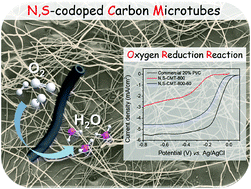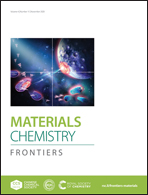Biomass-derived nitrogen and sulfur co-doped carbon microtubes for the oxygen reduction reaction†
Abstract
The development of environmentally friendly methods for the fabrication of new energy materials is being constantly pursued to relieve the global environmental and energy issues. During the past decade, carbon-based metal-free electrocatalysts with enhanced electrocatalytic performances by multiple heteroatom doping and superior electrical conductivity have shown their great potential to replace noble metal electrocatalysts in fuel cells. However, the fabrication of highly efficient carbon-based electrocatalysts from biomass and environmental waste remains challenging. Herein, we report the facile and scalable fabrication of nitrogen and sulfur co-doped carbon microtubes (N,S-CMTs) by pyrolysis of catkins (environmental pollutant) having adsorbed toxic dyes (water contaminant). With optimized parameters such as conductivity, doping, porosity, and surface area, the N,S-CMTs demonstrate significantly enhanced electrocatalytic performances in the oxygen reduction reaction (ORR) compared with those of commercial 20% Pt/C. Our work offers a promising alternative to platinum-based electrocatalysts toward the ORR in fuel cell applications.



 Please wait while we load your content...
Please wait while we load your content...